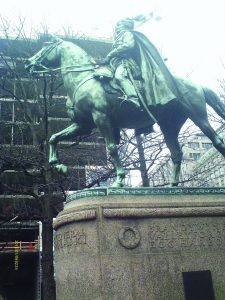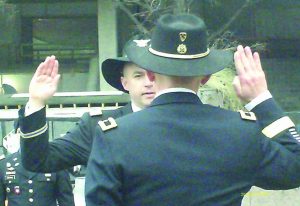By James C. Fulmer | Past President, NMLRA
“Count Pulaski of Poland, an officer famous throughout Europe for his bravery and conduct in defense of the liberties of his country against three great invading powers of Russia, Austria, and Prussia….may be highly useful to our service.” —Benjamin Franklin, in a letter to Gen. George Washington (Spring 1777)
When I received an invitation that read please join Maj. Mark O. Fulmer for promotion to Lieutenant Colonel, I will admit I was more than proud of my oldest son. It read the promotion will occur on the eastern end of Freedom Plaza at 1301 Pennsylvania Ave NW. Note: Stetson and Spurs are authorized. I called my son up and asked why there? Why my son replied, that is where the statue of Brigadier General Casimir Pulaski is located who is the Father of American Calvary. I have read and learned a lot about the American Revolution over the years and even remember reading the name Casimir Pulaski. But after visiting his statue in Washington, DC, at Freedom Plaza I realized what a large piece of history I had missed. Pulaski was more than a footnote in American history.

Statue in Washington, DC, of Brigadier General Casimir Pulaski, father of the American Cavalry
Benjamin Franklin recruited him in the spring of 1777 and by July of 1777 Pulaski arrived in Marblehead, MA. He sent a message to General Washington: “I came here, where freedom is being defended, to serve it, and to live or die for it.” By the end of August of 1777 he met with Washington at his headquarters outside of Philadelphia. Pulaski, while waiting for an officer rank to be given to him in the Continental Army, would be in his first military engagement of the American Revolution, the Battle of Brandywine Sept. 11, 1777. Because of his actions at the Battle of Brandywine he would be given the rank of brigadier general in the Continental Army Calvary. Pulaski would immediately begin in reforming the cavalry and he would write the first regulations for the formation and reorganization of the cavalry.
Pulaski would have difficulty dealing with people; he had what some described as an “imperious” personality, which meant he was thought to be overbearing, domineering and arrogant. Because of the friction and his ideas on discipline and tactics where so different from American commanders he had to leave his command. He would eventually go to Yorktown and meet with General Horatio Gates and with Gates’ recommendation Pulaski would be given a special title “Commander of the Horse.” He was authorized to form a lancer corps and light infantry. His corps became known as the Pulaski Cavalry Legion. Pulaski trained his men with tested cavalry tactics. It was during this time that he became the “Father of American Cavalry.”
When ordered to take part in the Sullivan Expedition against the Iroquois he became dissatisfied with this command and asked to be reassigned to the Southern front. General Washington would order Pulaski to South Carolina. He would arrive in Charlestown, SC in May of 1779. Here he arrived just in time for the defense of Charlestown. He would fight throughout that summer and would suffer from malaria while stationed at Charlestown.
General Benjamin Lincoln was the commander of the Southern Continental Army and in September he launched an attempt to retake the city of Savannah, GA. Here, during the Siege of Savannah, Casimir Pulaski would be fatally wounded by grape shot from artillery, while attempting to rally fleeing French forces during a cavalry charge. He died two days later on Oct. 11, 1779 at the age of 32.

Author’s oldest son Mark, facing camera, being sworn in as a Lieutenant Colonel in the United States Army at Pulaski monument in Washington, DC.
The United States raised cavalry units for the American Revolution and the War of 1812. But because of the great expense of maintaining mounted units in peacetime they were not retained at the end of a war. In the east with all of the rivers for transportation and the forested land, it was felt infantry was not at a disadvantage to mounted troops during this time period. Prior to 1832 the only mounted troops that served came from state militia units. These units where limited to only 90 days of service by law. But as the west opened up there was a need for more mounted troops. As muzzleloading firearms improved, more cavalry units were armed with long guns. Congress finally approved a Regiment of Mounted Riflemen armed with the 1841 rifle instead of the common smoothbore musket.
It was not be until 1855 that the US Army created mounted units that where actually called cavalry. They would be armed with the Colt cap and ball revolvers which had proved so effective in the Mexican War. By the outbreak of the Civil War the US Army had mounted regiments that where called dragoons, cavalry, and mounted rifles. In August 1861, it was decided to rename all these units as Cavalry; they were numbered according to the seniority of the regiment. The 1st Dragoons became the 1st US Cavalry; the First Cavalry Regiment became the 4th Cavalry.
I wonder if Casimir Pulaski could have guessed that his lances and horses would be replaced with mechanized armor and helicopters.
I am glad I had the opportunity to learn more about Casimir Pulaski, a true “Hero of the American Revolution.”
March is a busy month for me and if you are in the Michigan area on Saint Patrick’s Day, look me up. The 43rd annual Kalamazoo Living History Show takes place March 17th-18th, 2018. It is held at the Kalamazoo County Expo Center. It is a unique show that I love to go to because the time period goes up into 1890: French & Indian War, Revolutionary War, Civil War, to the great movement west. Lots of history and I enjoy listening to people talk about their time period. I will be there again this year with an 18th century “style” rifling machine. Also I will have an original .65 cal. straight grooved barrel. In case you never saw one, stop by and visit.



